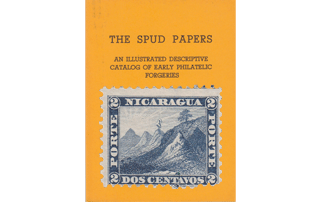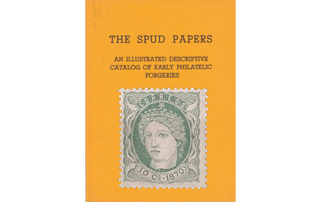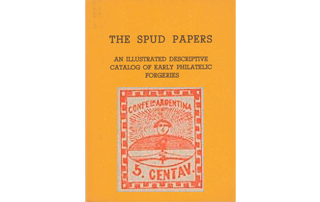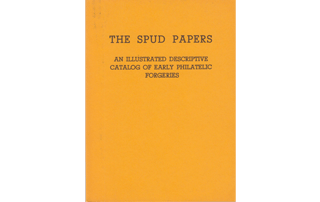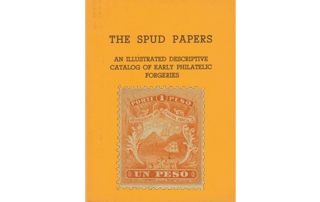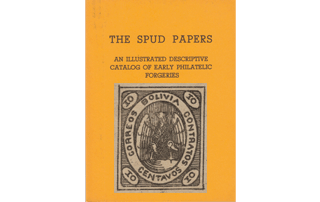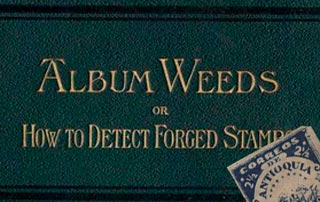

 Issue of 1858. 5, 10, 15 Centavos.
Issue of 1858. 5, 10, 15 Centavos.
From the coarse design of the originals, it might be thought that the forgers would turn out a good imitation of them; but, as will be seen by the following description, it would appear that even badly-made stamps are not always easy to counterfeit, though some of the forgeries which I have seen are much better than others.
Genuine
Lithographed, on white wove paper ; unperforated. In each corner there is a little upright oblong, by way of ornament. The key-pattern down the right side looks the same way as that down the left side; but it has a long piece sticking out at the bottom, and several times longer than the projection at the bottom of the left-hand key-pattern. The first letter of the word CONFEon is much nearer the left border of the stamp than the last letter of the word ARGENTINA is to the right; in fact, there is almost room for another letter to be added on the right side. There are two lines under the last two letters of CONFEon. They are very distinct in all my copies. The oval seems to be a shade more rounded on the right side than on the left, and it touches the border on both sides. In clear copies, there are twelve horizontal lines to be seen in the upper part of the oval, counting to the left of the cap of liberty, right up to the neck of the sun. The sun’s face is a little like the portraits of the Tichborne claimant. It has a pointed chin ; the mouth is slightly oblique, inclining downwards to the right; the hair is parted on one side, though this cannot always be seen; and the whole face is exactly above the center of the oval. The cap of liberty extends from the very bottom line of the shaded half of the oval, up to just touching the eleventh line. It is not very well drawn, but one can see what it is intended for. It does not come to a point like our illustration, but the upper end is quite blunt and rounded. There are two white marks upon it, a horizontal white patch, running nearly across, about the middle of it; and a sort of badly-made white diamond, with a dark mark in it, in the upper part of the cap. The point of the first A of ARGENTINA is 3/4 mm. from the inner outline of the frame above it, while the base of the E of CENTAV. is hardly mm. from the outline of the frame below it. The rays of the sun are composed of dots, except just at their outer ends, where they merge into lines, as though the dots had run into each other. The pole upon which the cap of liberty is placed is solid in heavily-printed copies, i.e., it is a thick line of color, and not merely outlined; but, in clearly printed specimens, it is composed of two separate lines. The pole shows up to above the level of the third line of shading in the oval, as though a piece had been cut out of the cap to show it. There is a stop, and sometimes two, after the 5, in the lowest value ; the other values have no stop after the numerals, and there is no stop after ARGENTINA in any of the values. The numerals are all upright.
First Forgery
Lithographed, on white wove paper, about the same substance as the genuine. The key-pattern on the left side looks the opposite way from that down the left side, and the little piece sticking out at the bottom of the left side is slightly longer than the piece sticking out at the bottom of the right-hand key-pattern. The c of C O N F E on and the last A of ARGENTINA are at about equal distances from their respective sides of the stamp. The two lines under the ON of CONFEon, which are of equal length in the genuine, are not alike in this forgery, the upper one being too short; they are also much too far apart. The central oval is too short, and does not touch the frame on either side. There are fifteen lines of shading in the upper half of the oval ;,they are quite distinct, and easy to count. The sun’s left eye and eyebrow (right side of the stamp) are blotched into one solid mass of color. The other eye appears to be squinting inwards. The cheeks are not so full as in the genuine, and the left cheek (right side of the stamp) is heavily shaded. The mouth turns up at both corners, and there is a perpendicular line joining the mouth and nose together, which is not found in the genuine. I cannot make out any parting in the hair. The cap of liberty is very like the one in our illustration ; it resembles a cow’s horn, is sharply pointed at the top, and is white, with two almost horizontal dark bands of shading across it, and a dark tip. This is a very easy instant test. The cap begins at the third line from the bottom, and reaches to the thirteenth line. The point of the first A of ARGENTINA is only I mm. from the frame above it, and the base of the E of CENTAV. is barely 1/2 mm from the frame below it. The pole on which the cap of liberty is placed is composed of three perpendicular lines, and the upper part of it can be seen to above the level of the fourth horizontal line in the oval. There is a stop after the numeral in the 5 and 15c., and none in the 10c. All the numerals are sloped very much to the right.
Second Forgery
Lithographed on stout, white wove paper, usually imperf., but some- times perf. 12 1/2. There is a different design for each value, the 5c. being the worst, and the 10c. the best. I shall have to describe each separately.
5 c. Forged
The four white corner-oblongs are as follows in this forgery : Left top corner, a sort of badly-shaped transverse diamond; left bottom corner, a transverse white blotch ; right top corner, a small white L ; right bottom corner, an oblique hyphen. One easy instant test for this forgery is the key-pattern, as the piece down the right side is joined to the top and bottom pieces. There is only one line under the ON of CONFEon, and the G of ARGENTINA is an unmistakable c, being quite destitute of the very marked cross-bar of the genuine. The oval is much more pointed on the right side than on the left. There are ten horizontal lines in the upper half of the oval. The sun has an extremely self-satisfied expression; the mouth is a perfectly straight line; the left eye (right side of the stamp) is round instead of long, and the dark mark forming the nose is shaped like an L, with its tail turned the wrong way, whereas the nose in the genuine is exactly like a J. The face does not seem to be exactly above the centre of the oval, but rather too much to the right. The cap of liberty is a roughly circular object, with a dark blotch in the middle, and with two colored lines coming from it into the unshaded half of the oval, and converging together where the pole meets the top of the hands. The pole is solid, and the cap extends from the first shaded line to the ninth. The point of the first A of ARGENTINA is fully 3/4 mm. from the frame above it, while the E of CENTAV. is very close to the frame below it (hardly 1/4 mm. from it), even closer than the genuine. No portion of the pole can be seen above the first line of the shading in the oval. There is a stop after the 5, as in the genuine. The portion of the key pattern under the 5, in the bottom label, points away from the 5; but in the genuine it points to the 5.
10 c. Forged
Lithographed, paper as before. The corner-ornaments are squares, instead of upright oblongs. The piece sticking out at the bottom of the key-pattern at the right side is like the genuine, but there is no similar projection at the bottom of the piece down the left side. There is only one line under the ON of CONFEon, and the cross-bar of the first A of ARGENTINA extends inwards only, instead of right across the lower end of the letter. The oval does not touch the frame either side. There are eleven horizontal lines in the upper half of the oval. The sun’s face has rather a Jewish look, with long, sleepy, closed eyes ; the mouth is nearly straight, and much thicker than in the genuine ; the hair has a very distinct white parting on the right side (left side of stamp) ; the chin does not touch the outline of the oval below it. The face seems to be set a little too much to the right. The cap of liberty is a shapeless blotch. It reaches from the first line of shading to about the ninth. I cannot describe it, as there is nothing on earth to which to liken it. The chief part of it is white. The point of the first A of ARGENTINA is a little more than J mm. from the frame above it, and the base of the E is nearly I mm. from the frame below it. The rows of dots forming the sun’s rays are arranged in such a way as to leave concentric semicircles of white all round the sun, and just above the sun’s head there are a number of short lines, though, in the genuine, there are neither dots nor lines close to the sun’s head. I have one specimen of this forgery which shows most of the rays as lines, instead of dots. The pole is composed of two lines below the hands, and a solid line above them. It seems to reach, as far as I can make out, to the second line of the shading of the oval. There is a stop after CENTAV. in this forgery.
15 c. Forged
Lithographed; paper as before. The white corner-ornaments are squares, except the one in the right top corner, which is a transverse oblong, or sometimes a round dot. There is no piece projecting vertically downwards from the key-pattern, either on the right side or on the left. There is only one line under the ON of CONFEon, and the G of ARGENTINA is similar to that in the 10c. just described. The oval barely touches the border on the right side, but it touches plainly on the left. There are twelve horizontal lines of shading in the top half of the oval, but the third and fourth from the bottom are so blotched together that they might easily be mistaken for a single line. The sun’s face does not touch the outline of the oval below it, except in heavily-printed copies; each eye is a horizontal dash ; the mouth is more of a human mouth than in the genuine ; the hair is parted almost in the middle, and the whole face is placed considerably too far to the right of the center of the oval. The cap of liberty is a shapeless object, reaching from about the fourth line to the tenth ; it is all white. The point of the first A of ARGENTINA is nearly 1/2 mm. from the frame above it, and the E of CENTAV. is about the same distance from the frame below it. Most of the rays of the sun are lines, instead of dots ; and one variety of this forgery shows some of these rays cutting right into the hair on the sun’s head. The pole is formed by two lines all the way ; it can be seen up to the fifth line of shading, and the lines of shading cut across it. There is a stop after CENTAV.
Third Forgery
I have only the 5 c. of this, but I dare say the whole set exists. Lithographed, on white wove paper, slightly thinner than the genuine. In each corner there is a small white square. The key-pattern is well imitated in this counterfeit. The two lines under the ON of CONFEon are too long; 1 1/2mm., instead of just a shade over 1 mm. There are ten horizontal lines of shading in the upper half of the oval. The sun has a rounded chin, partly cut off by the outline of the oval; the mouth is a straight line, with a sudden droop at the left-hand end (right side of stamp). The cap of liberty reaches from the bottom line of shading to the top one. It is of a sort of sloping oblong shape, with a very notice- able gap on the left side, between the third and fourth horizontal lines. Except for this wedge-shaped gap, there is no white in it at all. The pole cannot be seen above the beginning of the shading. If prolonged downwards, it would graze the beginning of the N of CENTAV.; though, in the genuine, it would pass clear to the left of the N.
Fourth Forgery
Of this I have only the 15 c. Lithographed (?), in dark blue, on thick, hard, white wove paper. The upright oblongs in the corners are only about half as wide as the genuine. The oval touches the frame on the right side, but not on the left. There are thirteen horizontal lines of shading in the upper half of the oval. The mouth is small and thick, the left eye seems to be shut, but the right one (left side of stamp) is like the genuine ; the hair is curly. The cap of liberty is exceedingly like that of the first forgery; it reaches from the bottom line of shading to the eleventh line. The point is even sharper than that of the first forgery. The rays round the sun are much too irregular, showing con- centric arches of white lines, formed by the breaks in the rays. In the genuine, these breaks do not form any pattern. The pole is darkly shaded, but shows two triangular patches of white above the hands, and one below them ; it is visible to level with the fourth line of shading. There is no stop after the 15, and a smaller one after CENTAV. The numerals slope strongly to the right. The G of ARGENTINA is not like the genuine, or any other forgery; it has no cross-bar, but a downward- pointing tongue (G).
Fifth Forgery
I have only seen the 5 c. of this, which came to me in 1902. Lithographed, on thick, very hard, white wove paper. There is a square in each corner. The key-pattern down the left side looks the opposite way from the one down the right side. The key-pattern at the top shows only two upward-pointing “keys,” with portions of two others; while the genuine shows four upward-pointing “keys.” The pattern at the bottom shows three upward-pointing “keys,” instead of four. There are no lines under the ON of CONFEon; the G of ARGENTINA is a C; and there is a stop after the word. The oval does not really touch the frame either side, but there is a small blotch, making a join between the oval and the frame, on the left side. There are eleven horizontal lines in the oval. The sun’s face is partly hidden by the postmark in my specimen ; but it seems to have wide-open eyes, a broad nose, with a perpendicular line joining it to the mouth, which is like a real mouth. The hair is parted very nearly in the center. The cap of liberty is like a cocked hat at the base, but terminates like a cap of liberty. It is all white, except a little shading at the center, and reaches from the second to the eleventh line of shading. The point of the first A of ARGENTINA is just 1/2 mm. from the frame above it, and the E of CENTAV. is 1/4 mm. from the frame below it. Many of the rays of the sun are very faint, so that there is a large patch which is almost white, to left of the sun. The pole is of solid color, and it shows up to the third line of shading. The tail of the 5 is a large, nearly round ball.
Sixth Forgery
Lithographed, in black ink, on green-faced paper. The 5 c. is the only value I possess of this forgery. Of course the green color instantly condemns it; but I had better give some details of the design. The oval touches the border on the left side only. There are seven very coarse lines of shading in the upper part of it, and a blotch, which is probably an eighth line, at the top. The hands are very large, and the lowest line of shading touches them. There is a black dot under the hands, indicating the commencement of the pole ; but the rest of the pole is invisible. The cap of liberty rests immediately upon the hands, and runs up to the top of the oval; it looks rather like a crooked claret-jug, but not in the least like a cap of liberty. The c of CONFER almost touches the border, and there are two lines under the ON. The halo round the sun is formed of dots, irregularly distributed, bounded by a number of thick strokes. Two of these strokes, on the right-hand side, touch the boundary-line. There is a stop after both 5 and CENTAV.
Postmarks
Genuine.—The usual postmark on the genuine stamps of this issue is a large, transverse oval, with name, etc., inside the curve, and FRANCO in large letters, in the centre.
First Forgery.—42, 100. Also an unoutlined oval, formed by very tiny dots. I have one specimen which bears two lines of print, without frame ; the upper word is FRANCO, but the lower one is illegible.
Second Forgery.—21, without the heads to the arrows, also something like 26, also 51, 98.
Third Forgery.—An unoutlined oval or circle, composed of very small diamond-shaped dots. Also a number of large oval dots, each one of them being the size of the C of CENTAV.
Fourth Forgery.—My specimen is not cancelled. Fifth Forgery.—Something similar to 26.
Sixth Forgery. —Uncancelled.

 Issue of 1861. 5 (10, 15) Centavos.
Issue of 1861. 5 (10, 15) Centavos.
I have seen no forgery of this issue as yet, but I would remind my readers that the 10c. and 15c. of this set were never issued to the public. They were distinguished from the first issue by having the key-pattern border very much smaller, with six pieces at top and bottom, and the lowest value
has the 5 very large; whereas the stamps of the first issue have a larger border, containing four
pieces at top and bottom in the same space as the six of this issue; and the figures of value on
each of the first set are a good deal smaller than the 5 of this issue.
Issue of 1861-2. 5 Centavos, rose.
There are two types of this stamp, and I think it better to describe both, so as to avoid the possibility of misconception or error. They are both lithographed, on soft, slightly surfaced, white wove paper. The unused copies in bright rose, red, and vermilion-red, now sold, are reprints of Type I., and the 10c. and 15c. sold with them are from the stone of the 5c., and are thus little better than forgeries, as the two genuine types of the latter values have not been reprinted, so far as I know.
Genuine. Type I., 1861.
There are 11 straight lines in the shield, and 72 pearls round the central circle. The 5 is large, with its head projecting almost as far to the right as the width of the body. The C of CENTAVOS is very small. The first A of ARGENTINA is much more pointed than the A of REPUBLICA. The little cross, separating the words of name, is formed by five almost circular, white dots. The branches of the wreath are very white ; and it is almost impossible to count the separate leaves. The top of the right- hand branch ends in two leaves, which point almost directly upwards. The top of the left-hand branch is rather sharp, and it points straight towards the sun. The arms and hands, supporting the pole which bears the cap of liberty, are represented by two parallel lines, very wavy, and passing in front of the pole. The cap of liberty rests on the second line of shading, and touches the tenth, counting from the bottom. The pole does not touch the outline of the oval beneath it.
Genuine. Type II., 1862.
There are 14. curved lines in the shield ; the lowest being much thicker than the rest. There are 74 pearls round the circle. The 5 is small, with a very short head, which projects to the right only about half as far as the width of the body. The C is a good deal larger than in the first type, and matches the rest of the letters. The A of REPUBLICA and the first A of ARGENTINA are both cut off very broad and square at the top. The little cross, separating the two words of name, is composed of four pear-shaped dots, surrounding one circular one. The branches of the wreath are nicely shaded, with almost every individual leaf distinct. There is one very small, darkish leaf at the top of the right-hand branch, which points decidedly to the left. The top leaf of the left-hand branch is very small, rounded like a white ball, and points above the sun. The arms and hands, supporting the pole which bears the cap of liberty, are represented by two almost straight lines, which pass behind the pole. The cap of liberty rests on the second line of shading, and comes a shade beyond the twelfth, counting from the bottom. The pole does not touch the outline of the oval beneath it. Stamps printed from the worn stone of this type show the spandrels almost white, as the radiating lines outside the circular part have almost disappeared.
First Forgery
Lithographed, on wove paper, very similar to that of the genuine. There are 10 straight lines in the shield, and 76 pearls round the circle. The 5 and c are imitated from Type II. of the genuine. The A of REPUBLICA is wider than the first A of ARGENTINA, like Type I. The letters AR of ARGENTINA, touch each other at the bottom in this forgery, but not in either type of the genuine. The side and bottom arms of the little cross which separates the words of name are pear-shaped ; the top one is round. In many copies the two side-arms run into the central dot. The wreath is very similar to that in Type II. of the genuine; while the coarse lines in the shield are more like those of Type I. The top leaf on the right-hand branch of the wreath is single, as in Type II.; and there are two very small leaves at the top of the left-hand branch, not like either of the genuine types. The easiest test for this forgery is the pole, which reaches right down to the very bottom of the oval shield; whereas, in both types of the genuine, it reaches only half-way between the arms and the bottom of the shield. The arms are represented by two parallel lines, passing in front of the pole ; the upper line on the left side does not touch the side of the shield, but is turned somewhat upwards, making the left side wedge-shaped. The cap of liberty rests on the bottom line of shading, and reaches up to the top line but one. In both types of the genuine, the rays of the sun make five zigzags below ICAAR. In this forgery, the ends of the rays are cut off in a curve, following the curve of the lettering above them, without any zig-zags. The pole goes down to the bottom outline of the containing-oval.
Second Forgery
Lithographed, on very white wove paper. This is, at first sight, very like the specimens from the worn stone of Type II.; that is to say, there are absolutely no radiating fine lines outside the circular portion of the stamp; indeed, no lines at all, except the two curved lines in each corner. There are no lines in the shield behind the cap of liberty, and there are 79 pearls round the central circle. The 5 is the small 5 of Type II. The tops of the A of REPUBLICA and the first A of ARGENTINA are about equally broad, both being cut off square. The A and R of this latter word are joined at their bases. Four out of the five dots, composing the little cross between the words of name, are blotched together; the one on the left side does not touch the rest. The wreath is something like that of Type II., but the two sides are much too short; the top of the right-hand wreath does not touch the rays of the sun at all, and the top of the left-hand wreath only touches the very last ray to the left; but, in both types of the genuine, the upper ends of the wreath cover over a great many of the rays. The arms are represented by two perfectly straight parallel lines, very wide apart; and it is difficult to say whether they pass in front of the pole or behind it, as the outlines of pole and arms are both visible where they cross.
Third Forgery
Lithographed, on thin, grayish-white wove paper. There are 11 straight lines in the shield, as in Type 1. of the genuine, but the third and fourth from the bottom are too far apart. There are 81 pearls round the central circle. The little cross between the words of name is formed by four large round dots, surrounding a small round dot. The wreath resembles that of Type I. The top of the right-hand branch appears to have three leaves on it; and two of them only just touch the very first ray of the sun, while the third does not touch the ray at all. The top leaf of the left branch, if prolonged, would pass far above the face of the sun. The arms and pole are very similar to those in Type I., of which this forgery is evidently an imitation ; but the cap of liberty is exactly like a leg of mutton ; it rests very nearly on the first line of shading on the shield, and reaches up to the same height as in the genuine Type I. There is a very strong, second upper outline to the shield in this forgery, hiding the mouth of the sun, which is not visible in the genuine Type I.
Postmarks
Genuine.—A long, pointed oval, containing name of town between two branches, all in three straight lines ; also CORREOS DEL arranged in a circle without any outline, and with date in three lines in the center ; also what appears to be a very large star of diamond-shaped dots; also a transverse oval, composed of a thick and a thin line very close together, and the ends of the oval concave instead of pointed, with three lines of inscription in the center; also a small postmark, something like 96 ; also an enormous pair of concentric circles, which would cover about four stamps at once, with name in very large letters in between the circles, and an inscription in a broad band across the middle ; also what appears to be a small, pointed oval of diamond-shaped dots ; also a very large oval of the said dots; also something like 13, but much larger, with CORDOBA FRANCA. None of these postmarks are outlined unless mentioned. They are nearly all struck in blue. Out of twelve cancelled stamps at this moment before me, only two are in black.
First Forgery.—Some enormous diamond-shaped dots, each almost as large as the shield ; also two large concentric ovals, the outer one blunter than the inner, with inscription between the ovals and in the centre ; also an imitation of a colonial postmark, similar to 54, without numerals.
Second Forgery.—A single curved line, which may be a portion of an enormous circle or oval. I have never seen any cancellation but this in the second forgery.
Third Forgery.—A set of five long parallel bars, like 98 ; also 37, without numerals. All these forged cancellations are in black.
Same Issue. 10 Centavos, green.
There are, as before, two types, but not identical with the two types of the 5 c. One has a very distinct white accent over the u of REPUBLICA; the other has no accent.
Genuine
Printing and paper as in the genuine 5 c. There are 14 straight lines in the shield, the lowest but one being crooked and badly drawn. There are 78 pearls round the circle. The cap of liberty extends from the second to the twelfth line, counting from the bottom. The left-hand branch of the wreath ends in a single leaf, which points towards the foot of the A of REPUBLICA.
Same Issue. 15 Centavos, blue.
There are two types of this stamp, as of the other values. I possess only the second type.
Genuine. Type II., 1862.
The paper and printing are the same as in the other genuine ones. There are 71 pearls round the circle and 15 lines in the oval shield.


 Issue of 1864. Unperforated; wmk. R. A.
Issue of 1864. Unperforated; wmk. R. A.
Issue of 1864-66. Perf. 11 1/2; wmk. R.A.
Issue of 1867. Thinnish paper; unperforated; no wmk. Ditto. Perf. 11.
Evans states that the two stamps of 1867 were re-issued in 1872.
Genuine
Engraved in taille-douce, on thick and on thinnish paper, as above. The watermark is in script letters. The unwatermarked and the unperforated ones are scarce. Although engraved in taille-douce, the impression, not only in the 5 c., but also in the higher values, is very unsatisfactory; the thick, hard paper apparently not lending itself to the requirements of this mode of printing. There is a 5 in each corner of the stamp, and each of them has a line of shading in the center of its white part; i.e., a line following the contour of the numeral. This is not very plain in the left lower 5, but very distinct in all the others. The value is written CENTAVOS, though the c and the S are not very plain, being blotchy, and somewhat hidden by the shading. The whole of the light part of the face, except the point of the nose, appears to be shaded all over with fine dots ; the nose is of a good shape, and stands out well from the face ; the bow of the cravat is distinct ; and the shirt-front is shaded all over with oblique lines, running down from right to left. In my specimens, the background, behind the bust, is perfectly solid, and it is quite impossible to see where the back of the head ends and the background begins, the latter is so very dark. The little crosses before and after CINCO are very indistinct, in con- sequence of the lines of shading being drawn over them ; and there are three lines to be seen between the left-hand cross and the C, and the same number between the right-hand cross and the O, one of the three lines in each case, touching the cross. The ink stands out sensibly from the paper.
Forged
Poorly lithographed, in a pale brownish-pink, on thick, hard, smooth, grayish-white wove paper, no watermark, unperforated. The surface of the stamp is very shiny, so that it feels quite greasy to the touch. None of the corner-numerals have any line of shading in them. The value is written SENTAVOS, the S being exceedingly like an 8. The final S is very distinct, having no shading on it. The whole of the face is quite white. The nose is very ugly and drooping, and does not stand out from the face. The bow of the cravat is almost invisible, and the shirt-front has no shading on it. The background, behind the bust, consists of a coarse lattice-work of crossed oblique lines, showing diamond-shaped interstices. This is a very easy test. As the background is so much lighter than in the genuine, the back of the head is tolerably plain. The cross before CINCO is very distinct, as there is very little shading on it; and there seems to be no shading between it and the C. The other cross is more like the genuine; but the three lines of shading do not reach from top to bottom of the label. The impression is perfectly flat to the paper.
Same Issue. 15 Centavos, blue.
Genuine
Paper, watermark, etc., the same as in the various issues of the 5 c. The c of REPUBLICA is not like a G, neither is the c of CENTAVOS. The 1 of 15 on each side goes a very little higher than the head of the 5. There is a three-lobed ornament in each corner of the stamp, and each of these ornaments has five triangular white patches, with dark dots in them, surrounding it—i.e., one near each point, and one between each two lobes ; but the one near the first N of ARGENTINA is not always very plain. The background of the central oval is very dark, so that the outline of the head and hair is very difficult to trace. The whole of the light part of the face is shaded with lines of oblong dots, with the exception of the point of the nose; and the darker parts of the forehead, where the dots run into lines, have the said lines very faint. The lips are rather thick, and the red parts are shaded with vertical lines, very little darker than the rest of the face. The outline of the red part is very nearly straight. Of course, when 1 speak of the “red part,” I refer to the part which would be red in a living person. The ornamental stop before QUINCE is exactly the same as the one after CENTAVOS; i.e., a colored ring, with a large round dot in its very center, and a small white dot in the center of the large colored one. The bow of the cravat is very lightly shaded. The plate never seems to be wiped clean; and consequently, the whole of the white parts of the stamp are invariably tinted more or less with the color of the impression.
Forged
Lithographed, on stout, very white wove paper, unwatermarked, badly pin-perf. i2j. The c of REPUBLICA is very like a G, and so is the C of CENTAVOS. The 1 of 15 on each side is, if anything, very slightly lower than the head of the 5. Each of the three-lobed ornaments in the corners of the stamp has only four triangular white patches, with dotted centers, surrounding it; that is to say, the four triangles which ought to be seen above the u of REPUBLICA, above the first N of ARGENTINA, below the I of QUINCE, and below the v of CENTAVOS are entirely absent. The outline of the head can be seen quite distinctly, as the background is too light, owing to the fact that the little pointed upright oblongs, with dark centers, in the said background, are not smeared with the color of the impression, as they invariably are in the genuine. Several parts of the face are perfectly white, without any dots or lines whatever; and the lines across the lower part of the forehead are too thick and prominent. The red part of the lower lip is nearly all white; that of the upper lip is of thick solid color, and absurdly bowed down in the center. In the ornamental stop before QUINCE, the outer ring is irregularly drawn, and the large dark dot is not in the center of it, but touches the lower part of the ring. The stop after CENTAVOS is better drawn, but the ring touches the outline of the label to the left of it, which is not the case in the genuine. The bow of the cravat is much too distinct, having very thick and heavy shading on it. There is not the slightest trace of smeared color over the white parts of the stamp, which are thus made too white and too prominent. The ink does not stand out from the paper, though it does very markedly in the genuine.
Postmarks
Genuine.—CERTIF in very large letters, probably part of the word CERTIFICADO; also 1, 29, 42 (without numerals), 59; also the large, transverse oval of the first issue.
Forged.—80 (bars thinner); also the large, transverse oval of the first issue.
Issue of 1867. 5 Centavos.
There are two types of this stamp. Type I. has the head on a background of horizontal lines; Type II. has the horizontal lines crossed by oblique ones. In addition, the head is re-drawn in Type II., and shows the outline of the collar above the AR of ARGENTINA almost straight, whereas it is rounded in Type I.
Genuine
Finely engraved in taille-douce, on rather thick, yellowish-white wove paper; perf. 12. If the stamp
be held obliquely towards the light, it will be seen that the ink of the impression stands out decidedly from the surface of the paper. Each A in the inscriptions is pointed—not a very acute point, but still not at all square. There are two white dots before and after REPUBLICA, and two similar ones before and after ARGENTINA—eight in all. In each case, the one dot is large and oval, and the other small and round. Between the shield and the CINCO CENTAVOS label, at the bottom of the stamp, there are two branches ; they appear to be olive-branches, with leaves and berries. The point of the shield is exactly above the center of the E of CENTAVOS.
Forged
Poorly lithographed, on stout, very white wove paper, showing a more regular grain than the genuine; perf. i2j. The forgers have imitated Type II., but the crossed lines of the background are very coarse. The ink does not stand out from the paper. In the words REPUBLICA ARGENTINA, each A has a wide, square top. The postmark, in my single specimen, covers the A of CENTAVOS, so I cannot say whether this is also square. The dots in the circular label are all round, except one of the two before REPUBLICA, which is merely a tiny white wedge. The branch above the vos of CENTAVOS is a bunch of wheat-ears (or it may be a bunch of bulrushes) ; the one over the CIN of CINCO is some unknown plant with a knobby head. The point of the shield is above the beginning of the space between the EN of CENTAVOS. I do not think this counterfeit is likely to deceive. My young readers must not confound this forgery with the genuine lithographed 5 c. of 1888-90, which is of almost exactly the same design, but is lettered CORREOS ARGENTINOS, instead of REPUBLICA ARGENTINA, and has no white dots before or after the words.
Same Issue. 10 c., green.
Genuine
This is only found with the background of crossed lines. It is engraved in taille-douce, like the 5c., on stout, hard, white wove paper; perf. 12. The face is shaded all over, except a small white patch above the right eyebrow (left side of stamp). There are four distinct, dotted horizontal lines of shading on the lower lip. There is a long lock of hair coming down to the center of the forehead, below the first A of ARGENTINA, and a much shorter, rounder lock, coming down a little way, above the right eye, and below the A of REPUBLICA. The small shields, right and left of the oval, show the arms perfectly distinctly, including cap of liberty, pole, clasped hands etc. There is a white, clearly-cut oval each side of D I E Z In consequence of the shape of the letters of the upper CENTAVOS. and lower inscriptions, many of them touch each other, either at the top or the bottom. For instance, in REPUBLICA ARGENTINA, the letters RE touch at the bottom; UB at the top; LI and CA at the bottom; TL at the top; IN at the bottom. In the lower inscription, the NT touch at the top, and TA at the bottom.
Forged
Poorly lithographed, on soft, medium, very white wove paper; perf. 13. The groundwork is of horizontal lines, though about three oblique crossing-lines may be made out to left of the head, but they cross the wrong way—down from left to right—whereas, in the genuine, they cross down from right to left. (I ought to mention that these crossing-lines in the genuine, hardly show at all on the right side of the stamp.) A large part of the face is entirely unshaded. There are no horizontal lines of shading on the lower lip, but only a blotch. The two curls on the forehead are very nearly the same size and shape—one is under the space between the two words of name, and the other is under the R of ARGENTINA. The arms in the two small shields are very indistinct. The lower half of the left shield is white, with dotted lines ; but in the genuine it is shaded with perpendicular lines—the gules of the herald. The white oval before DIEZ is very shapeless; the one after CENTAVOS is better. The CE of CENTAVOS appear to touch each other at the top, but none of the other letters of either inscription touch.
Same Issue. 15 c., blue.
Genuine
Engraved in taille-douce; paper and perforation as before. There are two types—one with horizontal lines only behind the head, and the other with crossed, horizontal and diagonal lines. The forgers have imitated the latter. The face bears a short mustache, clipped close at the corners of the mouth. The (very Gladstonian) collar shows on both sides of the face, and the vertical lines of shading on the collar are long and faint. The corner-numerals are on a ground of distinct, thick horizontal lines, partly crossed by perpendicular ones. The unshaded part of the nose is not very prominent. There are eight curiously-shaped leaves in the spandrels; and with regard to the four larger ones, if stems had to be added, they would run naturally to the nearest point of the circle containing the 15.
Forged
Lithographed, on soft, medium, very white wove paper; perf. 12 1/2, 13. The end of the mustache is long and drooping, and reaches nearly to the corner of the collar. The side of the lip looks as though a large slice had been taken out of it. The collar only shows on the left side of the face (right side of stamp). N.B.—Both genuine and forged show a dark end of necktie, sticking out on the left side, and this must not be mistaken for the collar. In the genuine the collar is white, and comes very near to the corner of the mouth, but this is absent in the forgery. The shading on the collar is composed of five very short, thick, dark perpendicular lines, and traces of two others. The numerals in the upper corners appear to be on a solid, or almost solid ground; in the lower corners the ground is of crossed lines. There is a very strong white patch running down the front of the nose, which is so prominent as to be almost the first thing to catch the eye. If stems were to be drawn to the three-pointed leaves near the numeral-circles, the stem of the one in the right lower corner would be drawn towards the o of CENTAVOS; the one in the right top corner towards the space between IN of ARGENTINA ; the one in the left top corner towards the P of REPUBLIC; and the one in the left bottom corner towards the numeral circle below it.
Postmarks
Genuine.—1 ; also a large transverse rectangular frame, with name and date.
Forged.—62, 98 (5 lines).


 Issue of 1877. Provisionals: “1” on 5c.; “2” on 5c.; “8” on 10c.
Issue of 1877. Provisionals: “1” on 5c.; “2” on 5c.; “8” on 10c.
These provisionals exist both with upright and with inverted surcharge ; I have no specimens of the latter, except as forgeries.
1 c. Genuine.
I cannot find any trace of indentation of the numeral into the paper, either in this or the other values, so I conclude that the surcharge is possibly lithographed. The I is 13 1/2 mm. high in the center,
hollowed, and 14 mm. high, measured up the back. My specimen is 4 3/4 mm. across the top, and 4 1/2 mm. across the bottom, above the base-line. The base-line itself is 8 mm. wide, and projects 1 1/2 mm. to left, and 1 3/4 mm. to right. It is nearly 3/4 mm. thick at the back. From the left top corner of the numeral to the outside point of the long serif there is a distance of 8 1/2mm., and the thinnest part of the serif, close to where it joins the numeral, is very nearly 1/2 mm. thick.
1 c. Forged
Of this I have only a specimen with inverted surcharge. The figure shows no sign of being indented into the paper. It is 13 1/4 mm. high, in the center of the hollow, and 13 1/4 mm. high up the back. It is 4 1/2 mm. across, near the top, and 4 1/4 mm. across near the bottom. The left end of the base-line, in my specimen, is cut off by the perforations, so I cannot say how long it is ; but the right side projects about the same distance as the genuine, though the inner corner, where it joins the upright stroke, is rounded, whereas the corner of the genuine is quite square. The out- side end of this base-line is hardly 1/2 mm. thick. From the left top corner of the numeral to the outside point of the long serif there is a distance of very little over 8 mm., and the thinnest part of the serif is not more than 1/4 mm. thick.
2 c. Genuine
The base of the numeral measures 10 3/4 mm.; it comes to a very acute point in front, and is 5 1/2 mm. high at the back. There is no sign of the numeral being indented into the paper.
2 c. Forged
The base of the 2 is 11 mm. long; it has a blunt point in front, and is nearly 6 mm. high at the back. The front of the base of the 2 is strongly indented into the paper in one of my specimens; which, by the way, are all with inverted surcharge. The blunt point in front is the best test, as the genuine comes to a point as sharp as a needle.
8 c. Genuine
This is printed on the 10c., green.
8 c. Forged
I have only a very absurd counterfeit, in which the surcharged “8” has been cut bodily out of a 10c. stamp, and let into a 5c., to produce the unknown variety of 8c. on 5c. By the aid of the microscope, the pattern of a part of the 10 can be seen in the cut-out black figure.
Postmarks
Genuine.—As before.
Forged.—The forged provisionals, of course, bear genuine postmarks.

 Issue of 1892. Columbus.
2 Centavos, light blue; 5c., dark blue.
Issue of 1892. Columbus.
2 Centavos, light blue; 5c., dark blue.
I got these counterfeits in 1898, but fancy they had then been in existence some months at any rate.
Genuine
Engraved in taille-douce on white wove paper, jR perf. 11 1/2, brownish gum, watermarked with an impressed rayed sun, the rays of various lengths, some of them nearly 8 mm. long. There is an accent over the U of REPUBLICA, and, in the word ARGENTINA, the letters AR and IN are joined together at their bases. The tail of the C of REPUBLICA curls slightly inwards, and the A almost touches the A of the following word. The 8 of 1892 is like an S, i.e., the loops do not join the body of the figure; while the ball of the tail of the 9 is not joined to the figure, but is, as it were, broken off. In the central picture, the oblique patch of land on the horizon, to the left, plainly reaches as far as the side of the vessel in the foreground; and the surface of the sea, where it joins the sky-line, is bounded by two strong dark lines, right across the stamp. There are three dark windows in the stern of the vessel, above the rudder. The three masts are quite distinct; the flag on the fore-mast (the mast furthest off) bears a very distinct dark cross ; the flag on the main-mast is divided into four compartments by two thin dark lines, crossing each other. The mizzen-mast shows a portion of a flag, the chief part of which is hidden by the sail; this portion has a distinct outline. All three masts are perfectly distinct, and can be seen from the deck right up to their points. The long pennant which hangs down from the great curved yard of the mizzen-sail shows, in its upper portion, a white cross on a dark ground. There are four sea-birds in the white patch of sky to right of the large ship, and three more birds (two of them not so distinct) above the white patch. If the horizon-line were prolonged to the right, it would cut deeply into the foot of the I of 1892. Like all taille-douce engravings, the genuine stamps very often show the whole of the face of the paper slightly tinted with the color of the impression. This is due to the imperfect wiping of the plate.
Forged
Nicely lithographed, on white wove paper, perf. 11 1/2, like the genuine, but backed with white gum. The ” watermark” is more deeply impressed than the genuine, and the rays of the sun are decidedly shorter, the longest of them measuring very little more than 5 mm. There is no trace of any accent over the U of REPUBLICA. None of the letters of any of the inscriptions touch each other, except the RE of OCTUBRE on the left side of the stamp, the bases of these being joined, though they are not so in the genuine. The tail of the C of REPUBLICA points distinctly outwards. The 8 of 1892 is of normal shape, i.e., both loops join the body of the figure; the 9 is also of normal shape, as the ball is joined to the tail of the figure. In the central picture the oblique patch of land slopes down into the sea before reaching the outline of the vessel; the boundary-line of the sea is no thicker than the rest of the lines representing the water ; there are no windows visible in the stern of the big vessel, above the rudder; the fore- and main-masts are fairly distinct for their whole length, but the mizzen-mast appears to go in front of its sail, and yet behind the great curved yard (if it really did this there would, of course, have to be a hole in the sail for the mast to pass through it!). The dark mark in the centre of the white flag on the fore- mast cannot be called a “cross,” as one of the arms is imperfect. The flag on the main-mast is divided into four compartments by two thick lines, crossing one another. The portion of flag on the mizzen-mast is not outlined, and the corner is not truly square, though it is square in the genuine. The long pennant has its upper portion shaped something like a Papal tiara, with no sign of a cross. The four sea-birds on the white patch of sky are fairly like the genuine; but in the darker portion, above the white patch, there is only one bird, instead of three. If the horizon- line were prolonged to the right, it would not even touch the foot of the 1 of 1892. To imitate the (usual) imperfect wiping of the plate, the 1 of 1892. To imitate the (usual) imperfect wiping of the plate, the forgers have covered the whole face of the counterfeits with a blue wash. This can be very easily seen in my counterfeit (which happens to have a portion of the edge of the sheet attached to it), as the wash extends 5 mm. beyond the impression.
Bogus stamp
Issue of 1889-90; 1/4c. surcharged “8,” in black, just over the ” 1/4″. This surcharge, as I suppose I need hardly say, is altogether bogus.
Essay
12 c., lithographed, ultramarine. A stamp something like the illustration, but with a border composed of curves and upright dashes, and without any caps of liberty, is to be found in almost everybody’s collection nowadays. I believe the stamp is an essay. It exists imperforate, perf. 12 1/2, and rouletted about 20.
Official Stamps.
 Issue of 1884. Upright Surcharge.
Issue of 1884. Upright Surcharge.
Genuine
I have two types before me, both said to be authentic. The letters are of the same height, but there is a difference in the spacing.
In the following tables the distances are all between the nearest points, except in the F—L, where the measurement is from the left-hand edge of the F to the very end of the horizontal limb of the L. This particular measurement I have taken, as being more exact than any attempt to measure the whole surcharge could be. It will be understood that the upright surcharge, whether genuine or forged, is always in black.
Forged
Of these I have five:
- In the first forgery the word is spelt OFICJAL
- The second forgery has some parts of the letters thicker than others
- The third forgery looks very well, but the letters are too widely spaced
- The fourth forgery is far too small
- The fifth forgery too tall. This last is found inverted.
Postmarks
Genuine.—I ; also with part of what appears to be a large square or oblong, containing lettering.
Forged.—All my specimens are cancelled with 1 or the oblong. These are genuine cancellations, the forgers having taken used stamps, on which to print their counterfeit surcharges.
From: ‘Album Weeds’, 3rd edition by R. B. Eareé. 1906
 For more information about the classical issues of Argentina, see —> René Jacobsohn’s exhibition
For more information about the classical issues of Argentina, see —> René Jacobsohn’s exhibition
See also –> Spud Paper – Argentina
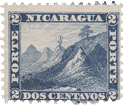
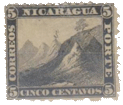 1862. 2 and 5 Centavos.
1862. 2 and 5 Centavos.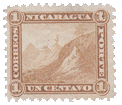 1871. 1 Centavo.
1871. 1 Centavo.
